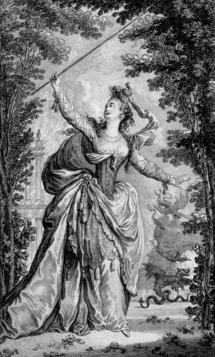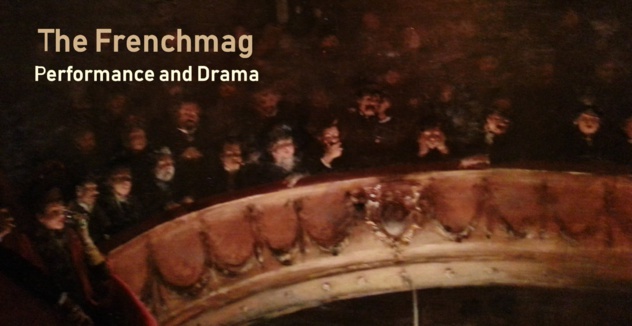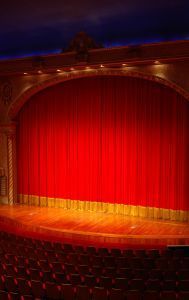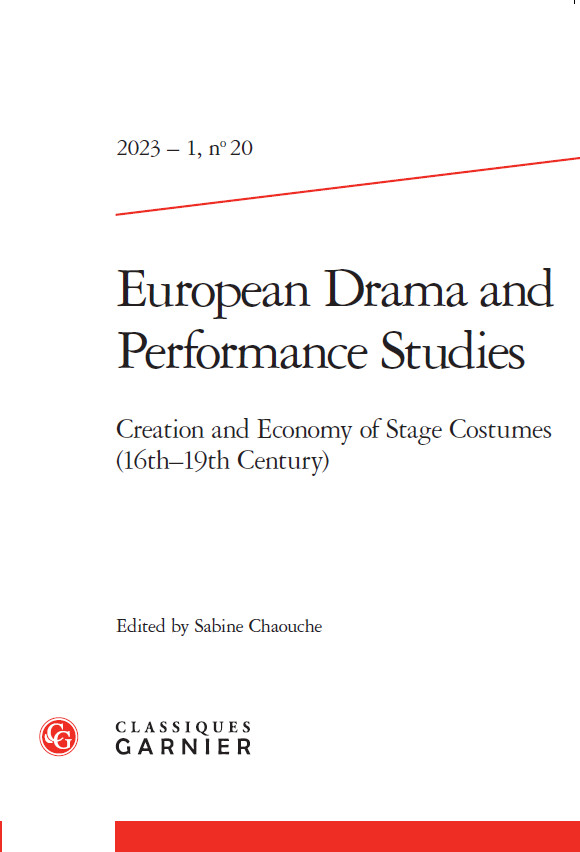
(c) Sabine Chaouche
Graceful gestures seemed to be a key element in acting over the century. Rules relating to acting were imported not only from rhetoric but also from dance (especially the different positions of the feet and the way in which one could have a good shape). Noble countenance was prioritized. This explains why some actors performing princes or princesses would want to rehearse regularly. They aimed to respect the aristocratic ideal of majesty. Throughout the century, some actors over rehearsed in front of a mirror in order to achieve elegance but only managed to produce stilted performances. Negative comments on these practices were made by various thinkers such as Claude Joseph Dorat, Servandoni d’Hannetaire or François Riccoboni. (1)
In 1790 amateurs acclaimed Mme Vestris for she had “wonderful” arms which “made beautiful movements.” (2) In L’Art du théâtre à madame*** published in 1750, the first chapter was devoted to gestures. This was very unusual and had no precedent. François Riccoboni stated that it was better to stand up straight but not too straight since a constrained actor could not move his arms easily and naturally (this opinion was later confirmed by Marie-Jean Hérault de Séchelles in Réflexions sur la declamation: “the body should be lean slightly”; “mid-body gestures are nobler (3) ”). According to Riccoboni, gestures in acting consisted mainly of moving the arms; though he accepted that they could also relate to the whole body. Later Hérault de Séchelles showed that noble gestures depended not only on the arms but mainly on the way in which wrists and elbows were positioned. Wrists should never be waived for instance. The best way to open the arms was to move them sideways using the elbows first. Gestures should be ample but few.
This emphasis on the arms suggests that they were absolutely crucial: they were regarded as the main medium to express emotions or reflect social conventions. Riccoboni claimed: “arms must act”. They had their own language and thus should be moved with harmony and coherence. He suggested that actors often did not know how to deal with both arms so the best way to keep a noble attitude was to hide them behind their back. He gave precise and useful details on the way in which actors should move their arms and finally warned against inappropriate gestures: “you must avoid stretching both arms at the same height, since this movement evokes musical performers waving to mark the end of a melody.” (4) He also disapproved of actors who stomped loudly on stage confusing clumsy movements with imposing attitude. These descriptions seem to correspond quite well with Favart’s caricature [see essay 5].
Could Riccoboni, author and actor, have been influenced by the fairgrounds and have wanted to point out what he saw as obvious failings and theatricalism in his peers? That is possible. Poor acting was often pointed out by thinkers over the century but they never mentioned any names. In 1747, Pierre Rémond de Sainte-Albine blamed actors who would be over hothead on stage (5); twelve years later Lebauld de Nans made the same remarks. (6) Some warned against foolish imitations of famous actors by novices or amateurs. Most critics would just suggest techniques to master the use of arm movement. Servandoni D’Hannetaire for instance advised beginners to tie their hands up to avoid gesticulation. (7) It is also clear that in the first part of the eighteenth century tragedians had limited space on stage (especially before 1759, the audience being seated on stage and occupying the sides of it, sometimes even the wings and the upstage). (8) Thus, actors had to keep a fairly static position. In his letters to Mrs Marie-Jeanne Riccoboni in 1758, Denis Diderot referred to half-circle positions on stage, with actors facing the audience, and he mocked these boring rhetorical instructions which controlled any movements of the arms (9). In his 1766 poem, though he did not mention any name, Dorat made fun of actresses who looked like ‘pagodas’ (little porcelain dolls with moving head) and walked as if on springs. These actresses were ruled by routine. He urged them to be more human and less self-conscious. (10)
Arms were also very important for creating impressive stage effects. They could be achieved by a flailing of arms: for instance Quinault-Dufresne used a theatrical trick in the mid-eighteenth century. According to Abbot Joseph Laporte and Jean-Marie-Benoît Clément, “during the first act while he was giving an account of Auguste’s crimes, Quinault-Dufresne kept his arm folded behind his back, holding his helmet with red plumes. When he uttered the following lines: “Here was the son covered in his father’s blood, holding his head and asking for revenge…” Out of the blue he produced the helmet and its red plumes and waved it frantically at the audience which was shocked and fascinated. At that moment it seemed that the blood-soaked head had appeared. (11) Subtle effects could also be achieved by a more thoughtful way of using the arms, i.e. by an economy of gestures or by creating contrasted movements. Mademoiselle Fusil explained that Mlle Sainval (part of Emilie in Cinna in the 1770s) would listen carefully to the other actors without looking at them. With her left hand on her elbow, she would answer them by talking to herself. When she would realize that she was betrayed, Miss Sainval would suddenly turn her head. This was felt to be a prodigious stage effect.
Sabine Chaouche
Acknowledgments: Many thanks to Monique Moreton for her readings and advice.
In 1790 amateurs acclaimed Mme Vestris for she had “wonderful” arms which “made beautiful movements.” (2) In L’Art du théâtre à madame*** published in 1750, the first chapter was devoted to gestures. This was very unusual and had no precedent. François Riccoboni stated that it was better to stand up straight but not too straight since a constrained actor could not move his arms easily and naturally (this opinion was later confirmed by Marie-Jean Hérault de Séchelles in Réflexions sur la declamation: “the body should be lean slightly”; “mid-body gestures are nobler (3) ”). According to Riccoboni, gestures in acting consisted mainly of moving the arms; though he accepted that they could also relate to the whole body. Later Hérault de Séchelles showed that noble gestures depended not only on the arms but mainly on the way in which wrists and elbows were positioned. Wrists should never be waived for instance. The best way to open the arms was to move them sideways using the elbows first. Gestures should be ample but few.
This emphasis on the arms suggests that they were absolutely crucial: they were regarded as the main medium to express emotions or reflect social conventions. Riccoboni claimed: “arms must act”. They had their own language and thus should be moved with harmony and coherence. He suggested that actors often did not know how to deal with both arms so the best way to keep a noble attitude was to hide them behind their back. He gave precise and useful details on the way in which actors should move their arms and finally warned against inappropriate gestures: “you must avoid stretching both arms at the same height, since this movement evokes musical performers waving to mark the end of a melody.” (4) He also disapproved of actors who stomped loudly on stage confusing clumsy movements with imposing attitude. These descriptions seem to correspond quite well with Favart’s caricature [see essay 5].
Could Riccoboni, author and actor, have been influenced by the fairgrounds and have wanted to point out what he saw as obvious failings and theatricalism in his peers? That is possible. Poor acting was often pointed out by thinkers over the century but they never mentioned any names. In 1747, Pierre Rémond de Sainte-Albine blamed actors who would be over hothead on stage (5); twelve years later Lebauld de Nans made the same remarks. (6) Some warned against foolish imitations of famous actors by novices or amateurs. Most critics would just suggest techniques to master the use of arm movement. Servandoni D’Hannetaire for instance advised beginners to tie their hands up to avoid gesticulation. (7) It is also clear that in the first part of the eighteenth century tragedians had limited space on stage (especially before 1759, the audience being seated on stage and occupying the sides of it, sometimes even the wings and the upstage). (8) Thus, actors had to keep a fairly static position. In his letters to Mrs Marie-Jeanne Riccoboni in 1758, Denis Diderot referred to half-circle positions on stage, with actors facing the audience, and he mocked these boring rhetorical instructions which controlled any movements of the arms (9). In his 1766 poem, though he did not mention any name, Dorat made fun of actresses who looked like ‘pagodas’ (little porcelain dolls with moving head) and walked as if on springs. These actresses were ruled by routine. He urged them to be more human and less self-conscious. (10)
Arms were also very important for creating impressive stage effects. They could be achieved by a flailing of arms: for instance Quinault-Dufresne used a theatrical trick in the mid-eighteenth century. According to Abbot Joseph Laporte and Jean-Marie-Benoît Clément, “during the first act while he was giving an account of Auguste’s crimes, Quinault-Dufresne kept his arm folded behind his back, holding his helmet with red plumes. When he uttered the following lines: “Here was the son covered in his father’s blood, holding his head and asking for revenge…” Out of the blue he produced the helmet and its red plumes and waved it frantically at the audience which was shocked and fascinated. At that moment it seemed that the blood-soaked head had appeared. (11) Subtle effects could also be achieved by a more thoughtful way of using the arms, i.e. by an economy of gestures or by creating contrasted movements. Mademoiselle Fusil explained that Mlle Sainval (part of Emilie in Cinna in the 1770s) would listen carefully to the other actors without looking at them. With her left hand on her elbow, she would answer them by talking to herself. When she would realize that she was betrayed, Miss Sainval would suddenly turn her head. This was felt to be a prodigious stage effect.
Sabine Chaouche
Acknowledgments: Many thanks to Monique Moreton for her readings and advice.
(1) “À ces bizarres Lois Dorilas fut soumis.
Sans cesse il consultait ce miroir infidèle,
Que le temps, chaque jour, obscurcit de son aile.
Servile imitateur, bouffon fastidieux,
Il n’aurait point osé se montrer à nos yeux,
S’il n’eût de son aïeul arboré la rondache,
Les antiques canons, et surtout la moustache.
Il mettait son orgueil à le représenter ;
Répétait ses accents qu’il s’était fait noter;
De rien imaginer affectait le scrupule ;
Et par tradition fut sot et ridicule.”
(Claude Joseph Dorat, La Déclamation théâtrale, poème didactique en trois chants (Paris: S. Jorry), 1766, pp. 70-71).
“Au reste, gardez-vous bien, Madame, de déclamer devant un miroir pour étudier vos gestes ; cette méthode est la mère de l’affectation : il faut sentir ses mouvements & les juger sans les voir.” François Riccoboni, L’Art du théâtre à madame*** (Paris: Simon fils et Giffart fils, 1750), 14.
“S’il arrivait qu’un Acteur n’eût pas de la nature le don de faire gracieusement usage de ses bras ; toute la peine qu’il pourrait se donner avec les secours d’un miroir, ne lui ferait acquérir que de l’affectation & non pas de la vérité ; & quoique l’on dise que Démosthène consultait un miroir pour composer ses mouvements, je ne sais si le soin qu’il se donnait n’était pas plutôt pour perfectionner les talents qu’il avait, & pour augmenter les agréments de sa Déclamation, que pour en corriger les défauts ?”
(Observations sur l’art du comédien, Paris, s.n., 1774, 291).
(2) Les Miniatures ou recherches sur les trois grands spectacles de Paris (Paris: s.n., 1790), 11.
(3) Marie-Jean Hérault de Séchelles, Réflexions sur la déclamation, in S. Chaouche, Ecrits sur l’art théâtral (Paris: Champion, 2005), II, 503.
(4)“Cependant il faut éviter d’avoir les deux bras également étendus, & de les porter tous deux à la même hauteur, car ce geste en croix dont les Musiciens accompagnent ordinairement la cadence à la fin d’un air, n’est point un modèle à suivre.” L’Art du théâtre à Madame ***, 13.
(5) Sept Traités sur le jeu du comédien (Paris, Champion: 2001), 556-557.
(6) Lettre à M. D. en réponse à des observations qu’il m’avait envoyées sur le théâtre, in Ecrits sur l’art théâtral, 361-372.
(7) Observations sur l’art du comédien, Paris, s.n., 1774, 204-205.
(8) See Barbara Mittman, Spectators on the Paris Stage in the Seventeenth and Eighteenth Centuries (Michigan: UMI Research Press, 1984).
(9) Ecrits sur l’art théâtral, 126.
(10) La Déclamation théâtrale, 43.
(11) French version: “Dans le cours de ce récit, il tint un de ses bras plié derrière son dos, tenant caché son casque surmonté d’un panache rouge. Quand il en fut à ces vers terribles :
Ici le fils baigné dans le sang de son père,
Et, sa tête à la main demandant son salaire
Indépendamment du feu qu’il mit dans la déclamation, il tira précipitamment le casque & le panache rouge, & l’agitant vivement, il sembla montrer aux Spectateurs la tête & a chevelure sanglante, dont il s’agit dans les vers. Ce qui jeta une frayeur & une surprise agréable dans tous les esprits.” (Pierre Corneille, Cinna ou la clémence d’Auguste, I.3, v. 202.) in Observations sur l’art du comédien, 141.
Sans cesse il consultait ce miroir infidèle,
Que le temps, chaque jour, obscurcit de son aile.
Servile imitateur, bouffon fastidieux,
Il n’aurait point osé se montrer à nos yeux,
S’il n’eût de son aïeul arboré la rondache,
Les antiques canons, et surtout la moustache.
Il mettait son orgueil à le représenter ;
Répétait ses accents qu’il s’était fait noter;
De rien imaginer affectait le scrupule ;
Et par tradition fut sot et ridicule.”
(Claude Joseph Dorat, La Déclamation théâtrale, poème didactique en trois chants (Paris: S. Jorry), 1766, pp. 70-71).
“Au reste, gardez-vous bien, Madame, de déclamer devant un miroir pour étudier vos gestes ; cette méthode est la mère de l’affectation : il faut sentir ses mouvements & les juger sans les voir.” François Riccoboni, L’Art du théâtre à madame*** (Paris: Simon fils et Giffart fils, 1750), 14.
“S’il arrivait qu’un Acteur n’eût pas de la nature le don de faire gracieusement usage de ses bras ; toute la peine qu’il pourrait se donner avec les secours d’un miroir, ne lui ferait acquérir que de l’affectation & non pas de la vérité ; & quoique l’on dise que Démosthène consultait un miroir pour composer ses mouvements, je ne sais si le soin qu’il se donnait n’était pas plutôt pour perfectionner les talents qu’il avait, & pour augmenter les agréments de sa Déclamation, que pour en corriger les défauts ?”
(Observations sur l’art du comédien, Paris, s.n., 1774, 291).
(2) Les Miniatures ou recherches sur les trois grands spectacles de Paris (Paris: s.n., 1790), 11.
(3) Marie-Jean Hérault de Séchelles, Réflexions sur la déclamation, in S. Chaouche, Ecrits sur l’art théâtral (Paris: Champion, 2005), II, 503.
(4)“Cependant il faut éviter d’avoir les deux bras également étendus, & de les porter tous deux à la même hauteur, car ce geste en croix dont les Musiciens accompagnent ordinairement la cadence à la fin d’un air, n’est point un modèle à suivre.” L’Art du théâtre à Madame ***, 13.
(5) Sept Traités sur le jeu du comédien (Paris, Champion: 2001), 556-557.
(6) Lettre à M. D. en réponse à des observations qu’il m’avait envoyées sur le théâtre, in Ecrits sur l’art théâtral, 361-372.
(7) Observations sur l’art du comédien, Paris, s.n., 1774, 204-205.
(8) See Barbara Mittman, Spectators on the Paris Stage in the Seventeenth and Eighteenth Centuries (Michigan: UMI Research Press, 1984).
(9) Ecrits sur l’art théâtral, 126.
(10) La Déclamation théâtrale, 43.
(11) French version: “Dans le cours de ce récit, il tint un de ses bras plié derrière son dos, tenant caché son casque surmonté d’un panache rouge. Quand il en fut à ces vers terribles :
Ici le fils baigné dans le sang de son père,
Et, sa tête à la main demandant son salaire
Indépendamment du feu qu’il mit dans la déclamation, il tira précipitamment le casque & le panache rouge, & l’agitant vivement, il sembla montrer aux Spectateurs la tête & a chevelure sanglante, dont il s’agit dans les vers. Ce qui jeta une frayeur & une surprise agréable dans tous les esprits.” (Pierre Corneille, Cinna ou la clémence d’Auguste, I.3, v. 202.) in Observations sur l’art du comédien, 141.




